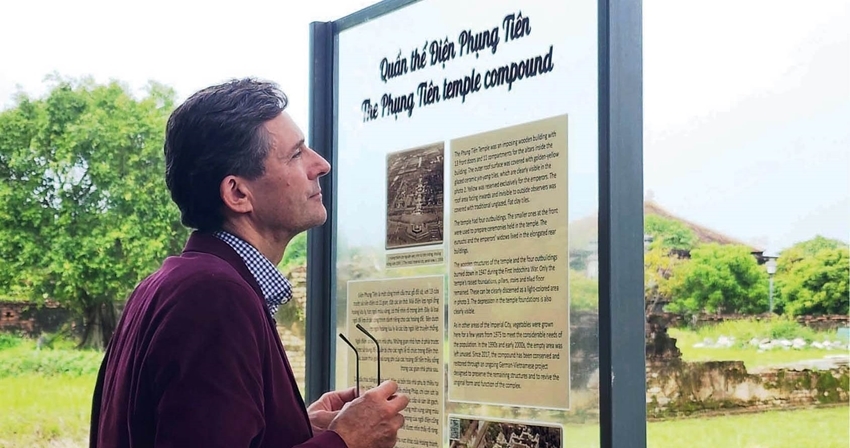 |
| Information about Phung Tien Palace being gathered |
Recently, on November 20th, Hue Monuments Conservation Center (HMCC) in collaboration with the Fulda Cultural Heritage Conservation Association, Germany (GEKE) organized the exhibition themed “Exploring the Complex of Phung Tien Palace” within the framework of the Heritage Conservation Cooperation Project between HMCC and GEKE (period 2017 - 2026) on preserving, renovating, and virtually restoring existing architecture of Phung Tien Palace, while at the same time integrating technical training for students at this site.
Reviving the site
Phung Tien Palace, originally named Hoang Nhan Palace, built in the 13th year of Gia Long’s reign (1814) to the north of Trieu Mieu for worshipping Empress Thua Thien - the Main wife of Emperor Gia Long, is one of five important palaces of the Nguyen Dynasty. In 1829, Emperor Minh Mang changed its name into Phung Tien Palace, and in 1837 moved it to its current location. At this time, the palace was built following the structure of “The Mieu Temple, which was divided into 9 compartments, with the shrine being in the front and the palace being in the back”, for the purpose of worshiping the emperors and queens of the Nguyen Dynasty. The site was where royal women were allowed to attend worshipping rites and practice daily incense burning.
The Palace precinct consists of 5 main works: the main hall, East - West Coordination Hall, Left - Right Tong Vien and many other auxiliary works such as the system of gates, doors, guarding screens, shallow tanks and rockeries, etc. In 1947, Phung Tien Palace was completely destroyed. Only the foundations of a few small structures such as the gates, the guarding screens, the shallow tanks and rockeries remained, though they were in a state of severe damage and at risk of complete collapse.
Mr. Hoang Viet Trung, Director of HMCC, informed: “Through the cooperation project between Vietnam and the Federal Republic of Germany in the period 2017 - 2019, the project of preserving and restoring gates, guarding screens, rockeries combined with in-depth technical training on Phung Tien Palace was urgently established and implemented to revive and sustainably preserve a work with many unique historical, cultural, architectural, and artistic values that our predecessors have passed down. This is also the first step for the plan to research and restore Phung Tien Palace in the future,” said Mr. Trung.
Recreating the site with technology
Having done the work of restoring and preserving Hue monuments for many years, the conservation expert representing GEKE e.V – Ms. Andrea Teufel – shared that she was concerned about “how to ‘empower’ a place as quiet as Phung Tien Palace, which has lost the most important structures, to tell its own story, as well as how to preserve and restore the remaining buildings to their original form and materials.”
“We have been doing this continuously since 2017, however, this is not enough to revive a heavily damaged building like Phung Tien Palace. Tourists still rush through this large precinct, hardly paying attention to the restored works such as the main gate or the two beautiful front and rear guarding screens,” expressed Ms. Andrea Teufel.
After many efforts, now the foundation of the palace under the rubble, soil and grass has been cleaned and preserved. The restored works are very unique with floor tiles being placed in their original positions and kept in a standard way, or simulated column bases being installed in place of the previous wooden columns, as an artistic image of the building’s massive size. These eye-catching structures also played an important role in the virtual reconstruction as a visual overlay of the existing space with a graphic model of the palace.
The exhibition is held outdoors, with a combination of reality, information, and virtual reconstruction technology models at Phung Tien Palace. Here, delicately designed QR arrays on glass panels allowing 3D scanning data and 3D models provide a brief “virtual tour”, arousing visitors’ interest.
The exhibition is a simulation of works at Phung Tien Palace shown by illustrations on transparent glass panels with appropriate viewing distance, giving visitors a complete experience of the virtual restoration in the form of a visual overlay of the existing space with a graphic model of the palace. In addition, there are layers of information and simulated images, adding different architectural elements shown directly on the glass panels and QR codes, which promise to bring visitors an interesting experience when visiting Phung Tien Palace, a palace once with only the foundation and typical auxiliary works remaining, which has now been completely restored inside Hue Imperial Citadel.
“Through the exhibition, we would like to disseminate information to the public so that they can have faster access to the historical story and overall construction of this meaningful palace. Meanwhile, we will continue to implement the restoration project of Phung Tien Palace until 2026, which involves building a surrounding wall and organizing exhibition activities on the opposite side of the palace grounds with vivid 3D images for visitors to admire,” excitedly shared Ms. Andrea Teufel.